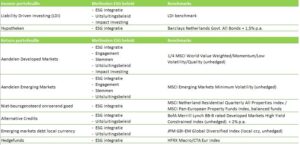Sustainable Finance Disclosure Regulation (SFDR) / EU Taxonomy
Stichting Heineken Pensioenfonds (the HPF) complies with the Sustainable Finance Disclosure Regulation (SFDR), the European disclosure regulations (2019/2088, 2020/852 and 2022/1288) on sustainable investments. Below you can read how the HPF meets the requirements.
Article 3 (2019/2088; Transparency of sustainability risk policies)
The HPF has a policy with regard to Socially Responsible Investment (the SRI policy). With regard to SRI we believe that a controlled integration of SRI aspects into our investment strategy and decisions can go hand in hand with aligning our investment return / risk objectives with our ambition to maintain the purchasing power of pensions. The guidelines for integrating sustainability risks into investment decision procedures can be found in the SRI policy.
Read more about our SRI Policy
Article 4 (2019/2088; Transparency of adverse sustainability impacts)
Under the SFDR a pension fund must indicate whether it considers principal adverse impacts of investment decisions on sustainability factors. The Board of HPF has determined on January 31, 2023 that, the HPF considers the main adverse effects of its investment decisions on sustainability factors.
SFDR obligates to use the template below to report on this.
Template Regulatory Technical Standards
PAI statement (only available in Dutch)
Article 5 (2019/2088; Transparency about remuneration policy)
The HPF pursues a remuneration policy that contributes to the prevention of (the appearance of) conflicts of interest, the prevention of taking unacceptable or undesirable risks, including sustainability risks, and the prevention of costs that are not in the interest of the stakeholders of the HPF.
The remuneration is independent of the return on the investment portfolio. The considerations about possible sustainability risks are therefore not influenced by the remuneration policy of board members or employees of the HPF.
With this the remuneration policy of board members and employees meets the legal requirements of the SFDR, the Financial Assessment Framework Decree, the Pension Funds Code and the Principles controlled remuneration policy of the Authority on Financial Markets (AFM) and the Dutch Central Bank (DNB).
Read more about our remuneration policy
Article 8 (2019/1288; Transparency about promoting environmental or social characteristics)
The HPF classifies its pension scheme as a sustainable product that promotes environmental or social characteristics. The HPF has not set sustainable investment as a goal for the pension scheme, however, the HPF does have the vision that as a long-term investor it can contribute to long-term social value creation and wants to implement this by integrating socially responsible investment into its investment policy. This classification is part of the SFDR.
The SRI policy explains what the objectives of the HPF are with regard to sustainable investment and how the sustainability characteristics are met (page 6 of the sustainability report 2021). In addition, information is provided on the methodologies (paragraph 1.3 of the sustainability report 2021), reference benchmarks, ESG indicators (paragraph 1.3.1 of the sustainability report 2021), data sources and screening criteria used by the fund (paragraph 1.3.2 of the sustainability report 2021).
Overview per investment category
The overview below shows per investment category in which the HPF invests which methods are used for the implementation of the SRI Policy.

Templates Regulatory Technical Standards
Precontractuele information (only available in Dutch)
Productinformation on the website (only available in Dutch)
EU Taxonomy (2020/852)
The EU Taxonomy is a classification system that provides insight into which financial products of economic activities are sustainable and which are not. The focus is on climate (ecological sustainability). The idea behind the EU Taxonomy is to combat greenwashing of finance and a concrete definition of too sustainable.
The HPF is required to disclose information under this Taxonomy Regulation. While there are potential investments in our portfolio that contribute to an environmental objective under the Taxonomy Regulation, the HPF cannot yet indicate to what extent the investments in our portfolio are in economic activities that could be considered sustainable under the Taxonomy Regulation. This is because insufficient reliable and verifiable data on the underlying evidence is available. For the time being, we therefore state that 0% of our investments are economic activities that can be issued as environmentally sustainable under the Taxonomy Regulation.
The HPF is actively monitoring this situation and when it determines that it has sufficiently reliable, certain and verifiable information about the investments of the portfolio(s), the HPF will provide the above descriptions.
The EU taxonomy sets out a “do no significant harm” principle by which Taxonomy-aligned investments should not significantly harm EU Taxonomy objectives and is accompanied by specific EU criteria.
The “do no significant harm” principle applies only to those investments underlying the financial product that take into account the EU criteria for environmentally sustainable economic activities. The investments underlying the remaining portion of this financial product do not take into account the EU criteria for environmentally sustainable economic activities.

